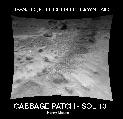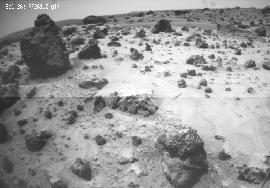Mars Pathfinder Image List

This image shows the Rover and terrain. (Courtesy JPL/NASA)

This image is a 360 degree panorama of the Martian landscape from the Mars Pathfinder lander. (Courtesy JPL/NASA)

Yogi + Rover tracks. (Courtesy JPL/NASA)

Rover's view of rocks & lander. (Courtesy JPL/NASA)

The Rover at work. (Courtesy JPL/NASA)

This image shows 3 classes of rock. (Courtesy JPL/NASA)
Surroundings

Twin peaks near the Mars Pathfinder landing site. (Courtesy JPL/NASA)

The Mars Pathfinder landing site. (Courtesy JPL/NASA)

The Mars Pathfinder landing site. (Courtesy JPL/NASA)

The Ares Valles outflow plain. (Courtesy JPL/NASA)

The Mars Pathfinder landing site & Ares Valles outflow plain. (Courtesy JPL/NASA)
Soils

Soils of Mars. (Courtesy JPL/NASA)

Soils of Mars. (Courtesy JPL/NASA)

Soil of Mars at the Mermaid dune. [There is no large version of this image]. (Courtesy JPL/NASA)
Rocks

Sojourner, Barnacle Bill, and Yogi. (Courtesy JPL/NASA)

Rocks near the Mars Pathfinder landing site. (Courtesy JPL/NASA)

Rocks near the Mars Pathfinder landing site. (Courtesy JPL/NASA)

The Rock Yogi. (Courtesy JPL/NASA)

The Rover studies the rock called Yogi. (Courtesy JPL/NASA)

The Rover studies Barnacle Bill. (Courtesy JPL/NASA)

A rock called Poohbear. (Courtesy JPL/NASA)

A rock called Ender. (Courtesy JPL/NASA)

A rock called Flat Top. (Courtesy JPL/NASA)

A rock called mini-Matterhorn. (Courtesy JPL/NASA)

A rock called the Shark. (Courtesy JPL/NASA)

The Souffle rock. (Courtesy JPL/NASA)

A conglomerate at the Mars Pathfinder landing site. (Courtesy JPL/NASA)
Drifts

Wind drifts at the Mars Pathfinder landing site. (Courtesy JPL/NASA)

Wind drifts at the Mars Pathfinder landing site. (Courtesy JPL/NASA)

Wind drifts at the Mars Pathfinder landing site, & Souffle rock. (Courtesy JPL/NASA)

Wind drifts at the *Viking I* landing site (labeled). (Courtesy JPL/NASA)
Sanddunes

Sanddunes at the Mars Pathfinder landing site. (Courtesy JPL/NASA)

The Mermaid dune. (Courtesy JPL/NASA)

Jenkins dune. (Courtesy JPL/NASA)

Sand dune images from the *Viking I landing site*, Chryse Planitia Basin (check the large topographic map of Mars). (Courtesy NASA/JPL)
Pebbles

Pebbles at the Mars Pathfinder landing site. (Courtesy JPL/NASA)

Pebbles at the Mars Pathfinder landing site. (Courtesy JPL/NASA)
Clouds

Clouds of Mars. (Courtesy JPL/NASA)

Clouds of Mars. (Courtesy JPL/NASA)

Clouds of Mars. (Courtesy JPL/NASA)

Clouds of Mars. (Courtesy JPL/NASA)

Temperature profile of the Martian atmosphere. (Courtesy JPL/NASA)

Temperature profile of the Martian atmosphere. (Courtesy JPL/NASA)
Sunsets

Sunset of Mars. (Courtesy JPL/NASA)

Sunset of Mars. (Courtesy JPL/NASA)

Sunset of Mars. (Courtesy JPL/NASA)
People involved with the Mars Pathfinder Mission

Some of the excited engineers and staff of the mission on landing day. (Courtesy JPL/NASA)

The staff of the mission being congratulated by the Vice-President of the United States at a press conference. (Courtesy JPL/NASA)

Some of the excited engineers and staff of the mission on landing day, including the project manager, standing in the middle of the picture. (Courtesy JPL/NASA)
Mars '98

The Mars '98 spacecraft being prepared for launch. (Courtesy JPL/NASA)
Go back to Mars, Pluto, Mercury, Saturn, Neptune, Venus, Moon, Jupiter, Asteroids, Comets, Sun, Missions, Uranus, Astrophysical Objects, Mariner, Viking, Mars Global Surveyor















